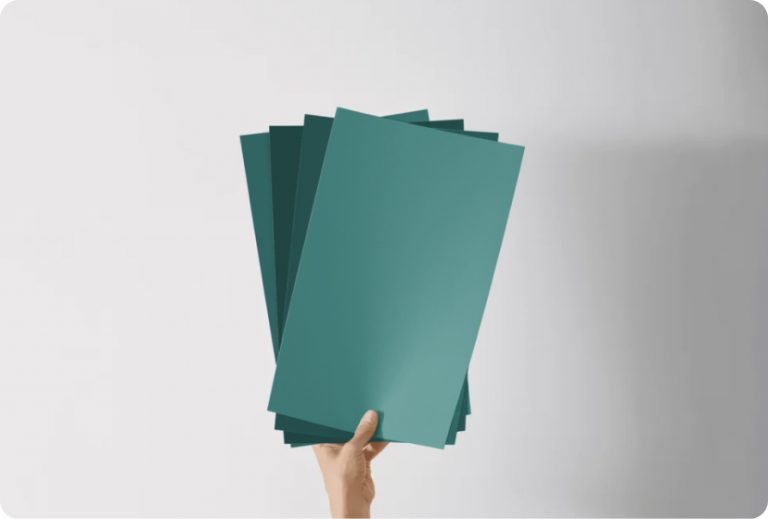If you are on the lookout for a color that brings richness and a traditional appeal to your living space, Sherwin Williams’ SW 9071 Dyer’s Woad could be the perfect choice for you. As a homeowner with a keen interest in finding that ideal blue that’s both warm and inviting, I’ve found this color strikes a wonderful balance. Its deep indigo hue instantly adds a sense of sophistication and historic charm to any room.
Dyer’s Woad by Sherwin Williams works well in both modern and classic interiors, proving its versatile ability to uplift various design aesthetics. I’ve used it in the dining room paired with soft whites and natural woods, which highlights its depth and enhances the overall ambiance of the space.
Whether you are looking to repaint your bedroom to create a cozy retreat or want to make a statement in your entryway, Dyer’s Woad provides a beautiful backdrop that complements a range of decors and styles. From my experience, this shade pairs particularly well with muted earth tones and metallic accents, allowing you to create a coherent yet diverse color scheme within your home.
It’s been a pleasure seeing how this color transforms different rooms with its timeless elegance.
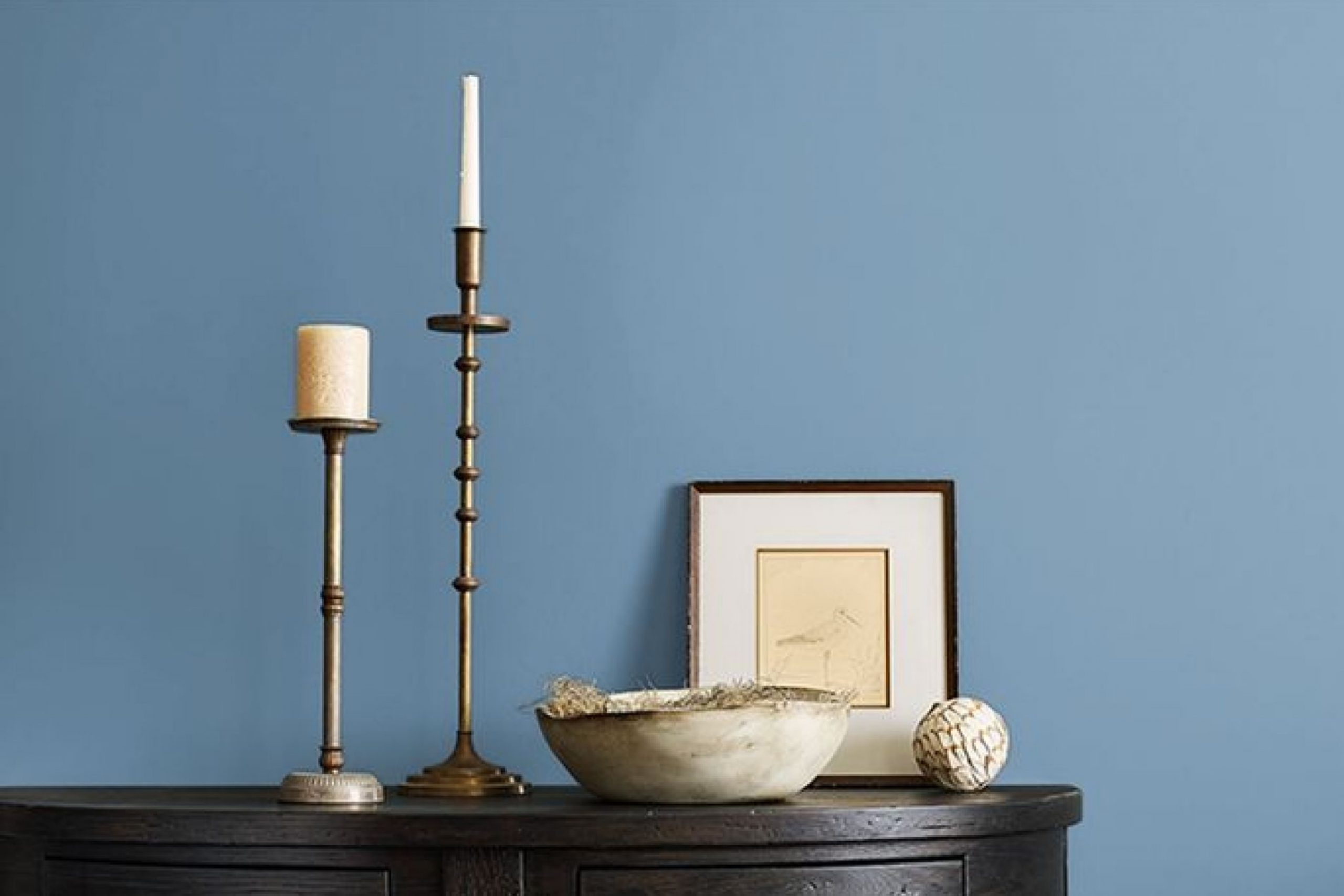
What Color Is Dyer’s Woad SW 9071 by Sherwin Williams?
Dyer’s Woad by Sherwin Williams is a unique shade that beautifully blends blue with subtle gray undertones, resulting in a color that exudes a fresh and airy feel. This versatile hue can easily adapt to a variety of interior styles, making it a popular choice for those looking to refresh their living spaces.
In terms of interior design, Dyer’s Woad works wonderfully in contemporary and minimalist settings due to its clean and crisp nature. It can also be effectively incorporated into a coastal or Scandinavian style, where light colors and natural light are prominent.
This color pairs exceptionally well with natural materials such as light wood, rattan, and linen, enhancing its organic feel. When combined with metallic finishes like brushed nickel or stainless steel, Dyer’s Woad achieves a more modern look, while pairing it with warm woods or rich textures can create a cozy, inviting atmosphere.
When used in an interior, this color looks striking against pure white trim, which highlights its depth. For a more daring and dynamic interior, contrasting colors like mustard yellow or burnt orange can be introduced through accessories or furniture, providing an enticing visual pop against Dyer’s Woad’s cooler tones.
Overall, this color is a smart pick for anyone looking to freshen up their space with a touch of refined yet relaxed color.
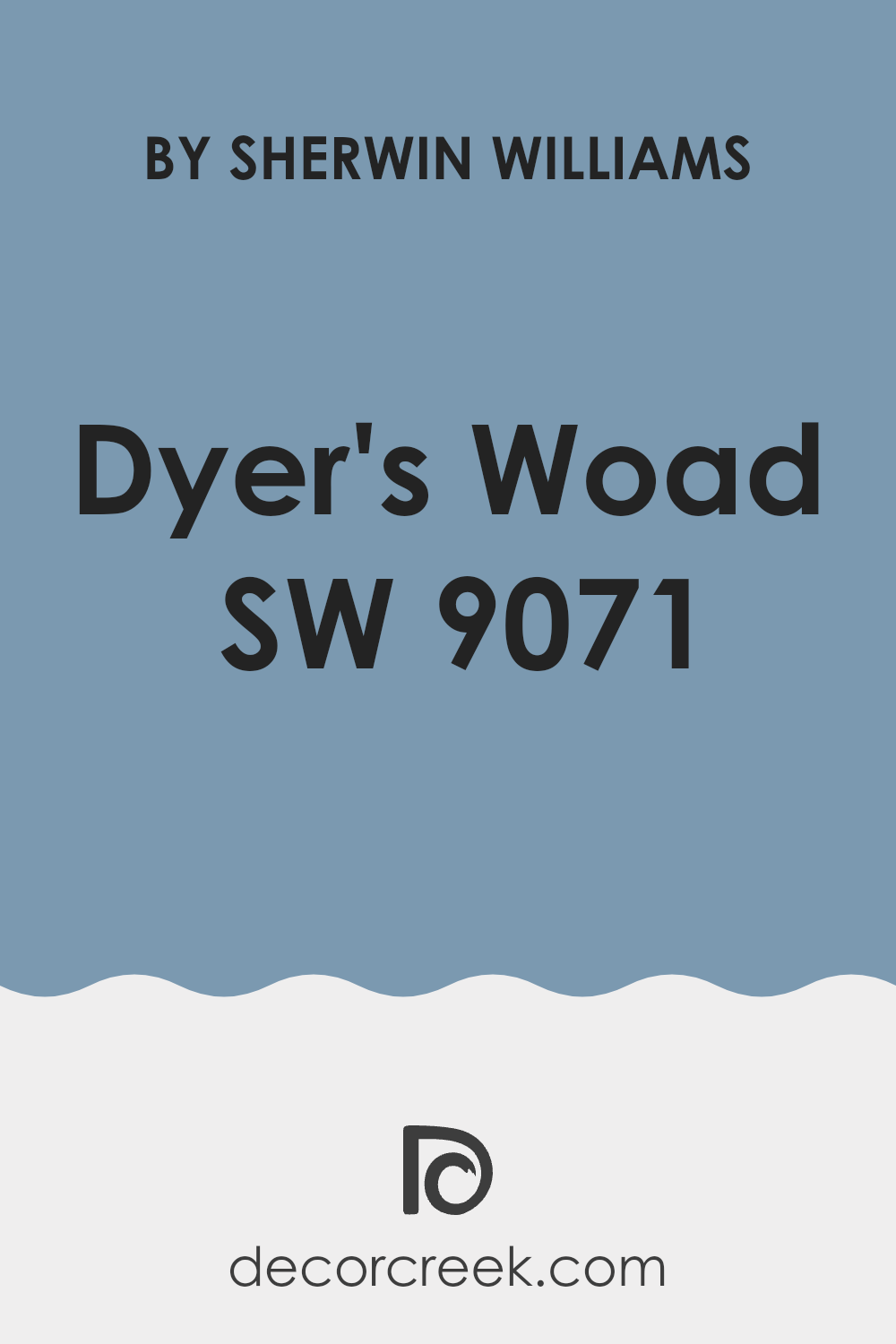
Is Dyer’s Woad SW 9071 by Sherwin Williams Warm or Cool color?
Dyer’s Woad is a rich and vibrant blue paint color by Sherwin Williams. This shade brings a lively yet comforting feel to any room in a home. Great for both small accents or big statements, it pairs well in kitchens with white or light wood cabinets for a fresh, modern look.
Using it in living rooms or bedrooms can add a cozy, inviting touch, especially when combined with soft lighting and natural textures like wood or wool. This color also works well in a bathroom, offering a clean, cheerful vibe that’s perfect for starting your day.
In terms of decorating, Dyer’s Woad goes nicely with various colors. It looks beautiful next to grays, creams, and even some greens, allowing for versatile design choices.
Whether you’re painting an entire room this color or just using it for an accent wall, it is sure to lift the atmosphere and add a delightful pop of color to your home.
Undertones of Dyer’s Woad SW 9071 by Sherwin Williams
Dyer’s Woad is a unique paint color offered by a popular brand, known for its depth and versatility. Its main color might be difficult to pin down at a glance, given it carries multiple undertones which include shades of gray, light blue, mint, and even light purple among others. Undertones are subtle colors lying beneath the surface of the main color. They can significantly influence the overall look of the paint depending on lighting conditions and surrounding colors.
In interior walls, these undertones affect how Dyer’s Woad appears throughout the day. Under natural light, light blue and mint undertones might make the wall feel fresh and lively, whereas in artificial lighting, the grays and darker blues could give a more grounded, calming look.
This means the color can shift from appearing cool and refreshing during the day, to more composed and cozy at night.
The versatility of Dyer’s Woad with its range of undertones makes it suitable for various rooms. In a bedroom, the softer undertones like light purple and pale pink could contribute to a relaxing atmosphere.
In a living room, the stronger undertones like navy and dark blue provide a striking background that complements both modern and traditional decor.
Understanding the effect of these undertones can help in choosing furniture and decorations that enhance the environment, reflecting either a comforting or vibrant space, according to the desired ambiance. Thus, choosing a color like Dyer’s Woad can offer a dynamic palette that adapts subtly to changes in light and space usage.
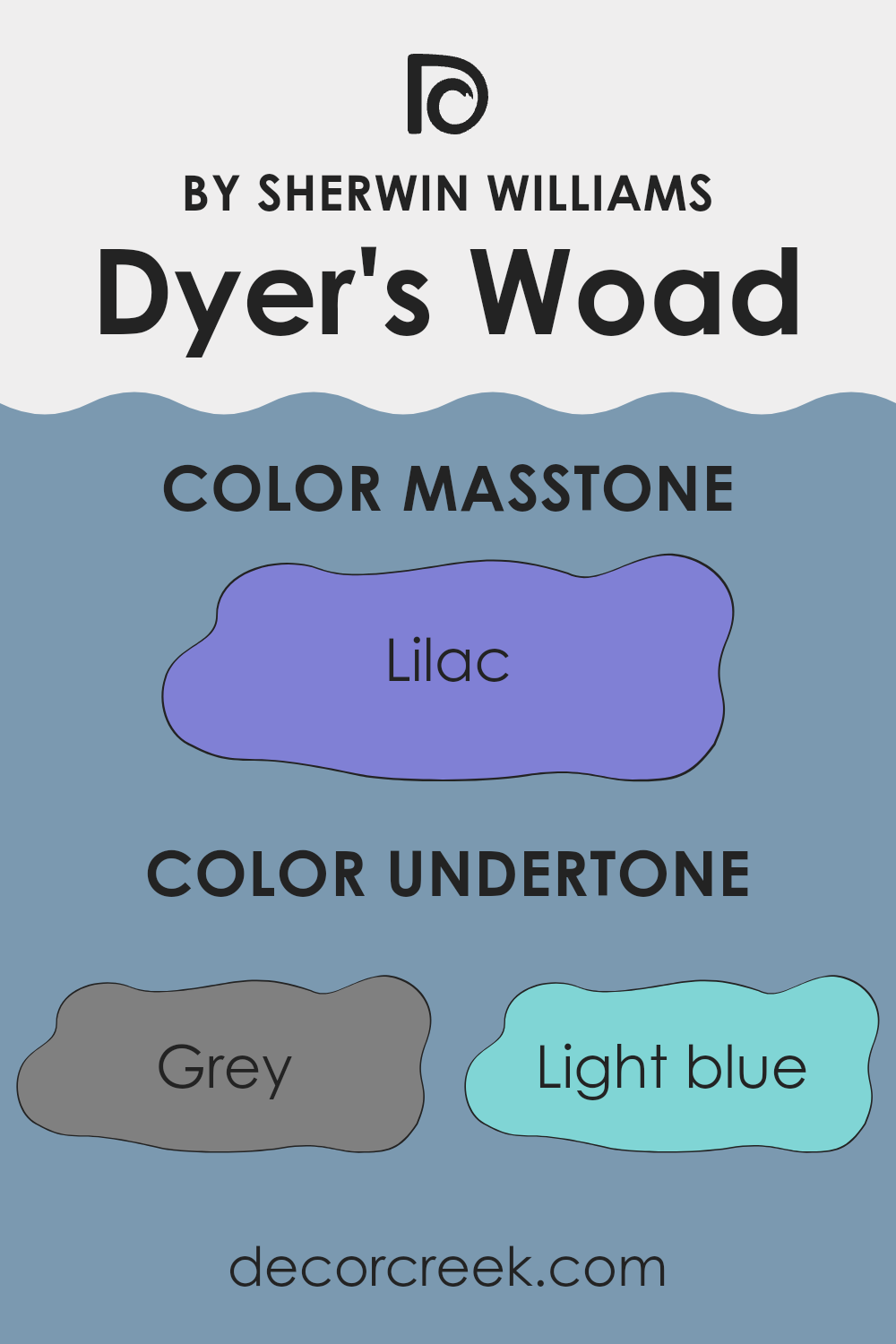
What is the Masstone of the Dyer’s Woad SW 9071 by Sherwin Williams?
Dyer’s Woad, with its masstone of Lilac (#8080D5), brings a subtle charm to any room in a home. This shade of light bluish-purple is mellow and inviting, making spaces feel cozy and pleasant. When used on walls, it offers a calm, gentle backdrop that can help smaller rooms appear brighter and more spacious.
The coolness of the lilac hue works well to relax the energy in a busy kitchen or as a fresh touch in a bathroom. For bedrooms, it pairs beautifully with soft white or creamy textiles, creating a restful retreat.
Additionally, this color can be a playful yet muted choice for children’s rooms, where it harmonizes well with various decor styles and does not overpower the space with brightness. Overall, Dyer’s Woad in the shade of Lilac is versatile enough to fit in modern and traditional homes, subtly enhancing the atmosphere without dominating it.
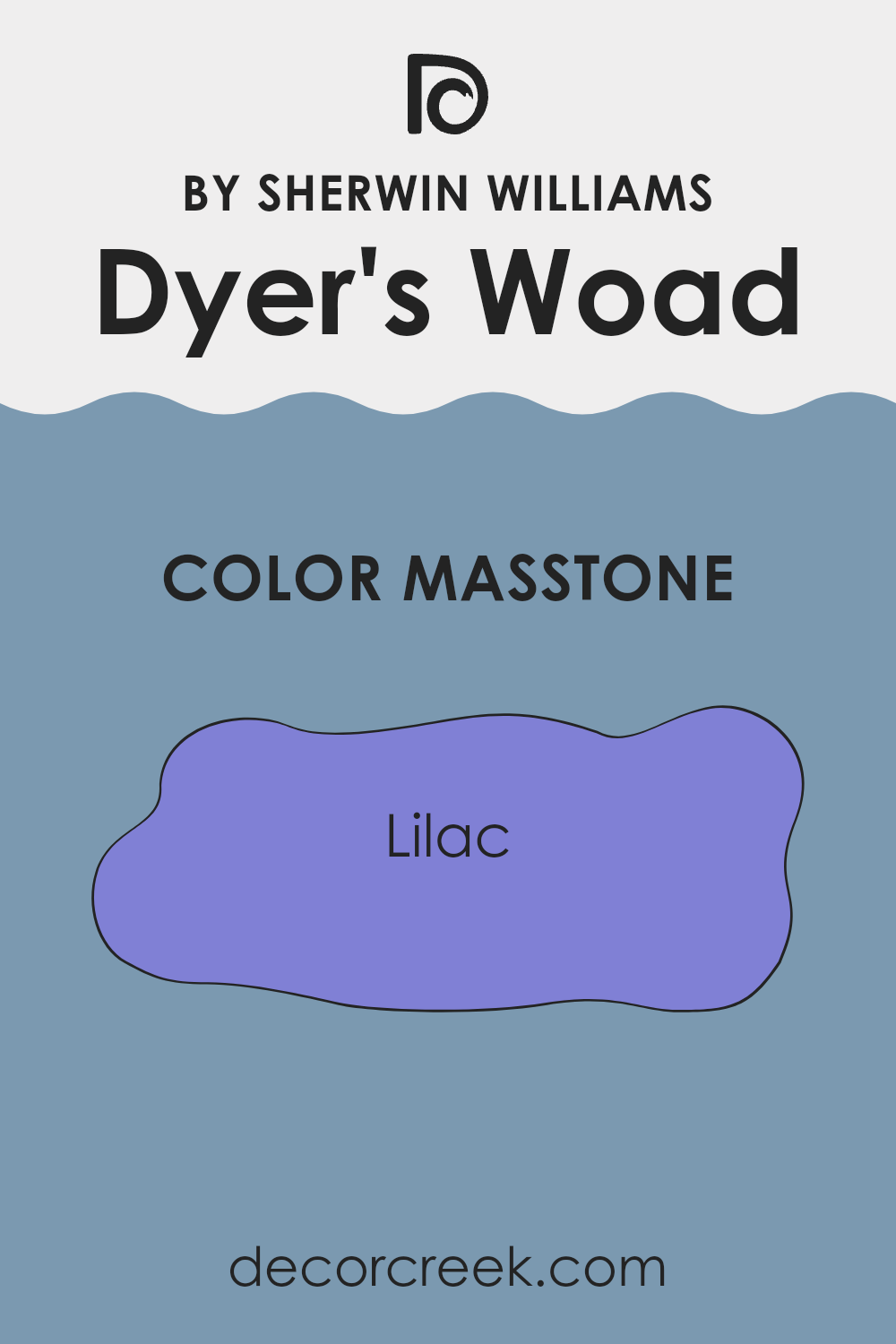
How Does Lighting Affect Dyer’s Woad SW 9071 by Sherwin Williams?
Lighting plays a crucial role in how colors appear in a space. This effect varies significantly between natural and artificial light sources. A color like Dyer’s Woad SW 9071 by Sherwin Williams can look different depending on the type of light illuminating it.
Under artificial light, such as LED or fluorescent bulbs, Dyer’s Woad SW 9071 can appear slightly different than under natural sunlight. Artificial light can either warm up or cool down its blue tone depending on the bulb’s color temperature. For instance, warm yellow lighting can make it look more muted, while cool white bulbs might enhance its blue tones, making the color appear more vibrant.
In natural light, Dyer’s Woad SW 9071 shows its true color but varies with the direction of the room. Rooms that face north get less direct sunlight, which can make the color appear a tad darker and more subdued. This could make cozy spaces feel more closed but stylishly so.
In south-facing rooms, which receive abundant sunlight, Dyer’s Woad SW 9071 might look brighter and more cheerful. The ample light can bring out the lively aspects of the color, perfect for spaces used during the day.
East-facing rooms see bright light in the morning, which can make Dyer’s Woad SW 9071 look exceptionally vibrant and fresh. As the day progresses, the color may lose some of its brightness but still hold a pleasant tone.
West-facing rooms get more sunlight in the afternoons. Here, Dyer’s Woad SW 9071 will have a warm glow in the evening, making the environment relaxed and inviting as the sun sets.
Understanding these variations can help in choosing right furnishings and decor to complement the room’s lighting and use Dyer’s Woad SW 9071 effectively to enhance the aesthetics of a space.
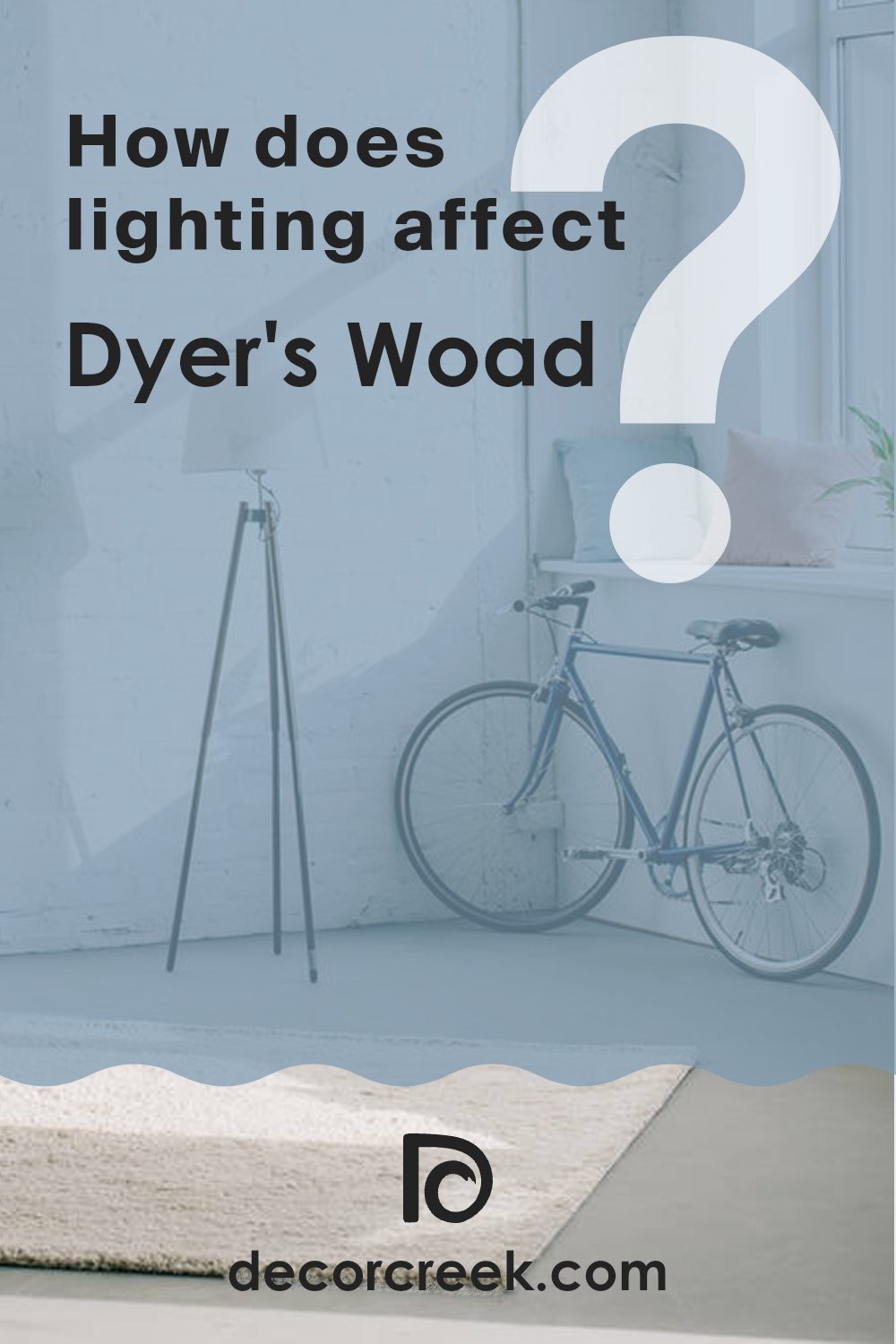
What is the LRV of Dyer’s Woad SW 9071 by Sherwin Williams?
LRV stands for Light Reflectance Value, which is a measure of the amount of visible and usable light that gets reflected from a surface when light shines on it. The scale for LRV runs from a low of 1 to a high of 99, indicating a spectrum from very dark to very light colors. Higher LRV values mean the color reflects more light, making the space feel brighter and larger. Conversely, lower LRV values mean the color absorbs more light, which can make a room feel cozier but smaller and darker.
The LRV of Dyer’s Woad, which is 30.19, suggests that it is a darker shade. This means it won’t reflect a lot of light back into the room. In practical terms, if you paint a room with this color, it might feel more enclosed and intimate.
This could work well in a larger space or a room with plenty of natural light, helping to balance the brightness. However, in a smaller or poorly-lit room, this color might make the space feel even smaller and darker. When choosing colors with lower LRV, it’s good to consider the room’s lighting and size to achieve the desired effect without making the room feel too tight.
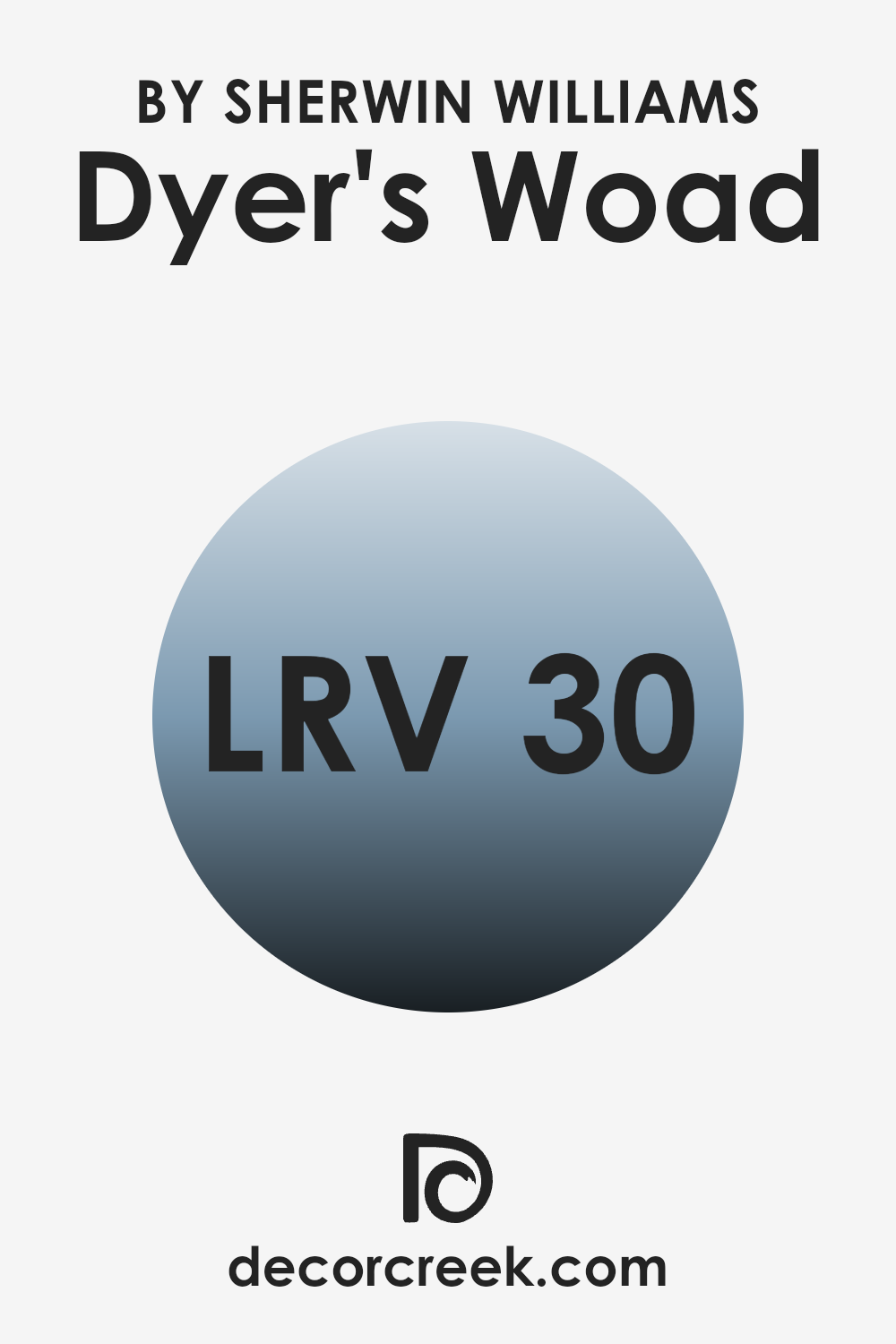
Coordinating Colors of Dyer’s Woad SW 9071 by Sherwin Williams
Coordinating colors are selected shades that harmonize well with a main color to enhance the overall aesthetic of a space. When working with a primary color such as Dyer’s Woad by Sherwin Williams, choosing colors like Rarified Air, Tres Naturale, and Song Thrush can create a cohesive and visually pleasing palette. These colors complement or contrast effectively, offering balance and unity to design.
Rarified Air is a soft, pale blue that brings a light and airy feel to the room, making it an excellent choice for creating a calming atmosphere. It pairs nicely as a backdrop for the deeper tones of Dyer’s Woad.
Tres Naturale, on the other hand, is a muted green that lends an earthy, grounding effect when used alongside bolder colors. This shade works well in spaces aiming for a natural, understated look. Finally, Song Thrush is a warm taupe that provides a subtle, cozy warmth, offering a perfect balance to cool tones in the room, ensuring the environment feels inviting and harmonious. These coordinating colors work together to enhance the beauty and expressiveness of the primary color, improving the overall design scheme.
You can see recommended paint colors below:
- SW 6525 Rarified Air
- SW 9101 Tres Naturale
- SW 9112 Song Thrush
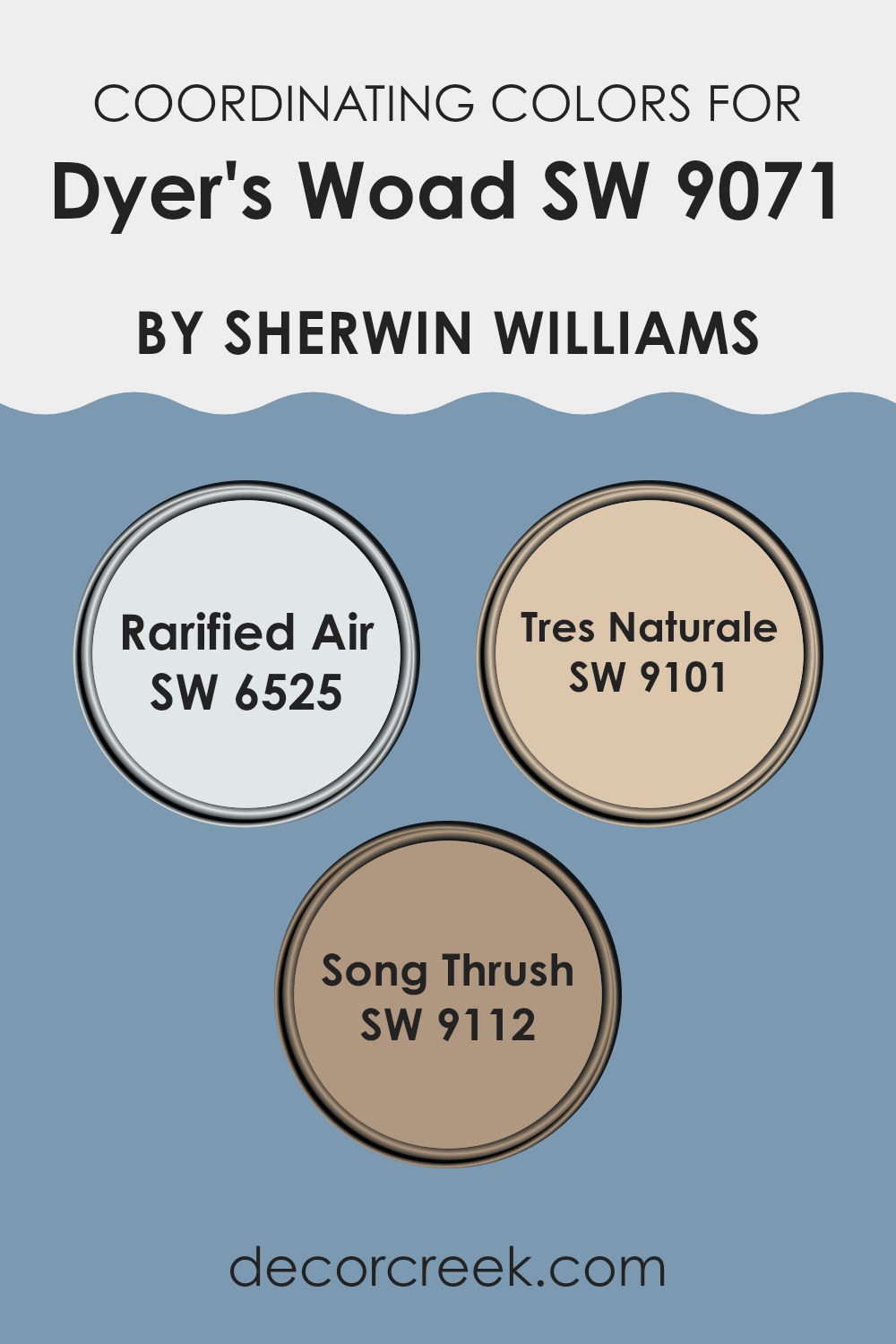
What are the Trim colors of Dyer’s Woad SW 9071 by Sherwin Williams?
Trim colors are those used on smaller surfaces like door casings, moldings, and window ledges to contrast or complement the wall colors in a room. In the case of a distinctive color like Dyer’s Woad by Sherwin Williams, choosing the right trim colors enhances the overall aesthetic of a space and helps define architectural details. For instance, when Dyer’s Woad is paired with lighter or neutral trim colors, it can make the wall color stand out more prominently, providing a clean and finished look.
Toque White by Sherwin Williams is a light and airy shade that can be used as a trim color to give a fresh and bright appearance against the richer hue of Dyer’s Woad. It doesn’t overwhelm but rather supports the main color to create a balanced and welcoming atmosphere.
Another excellent option for trim is Wool Skein, a subtle, warm beige that offers a soft contrast, adding warmth and a gentle distinction without competing with the main color tone. This color works well to blend the transitions between colors smoothly, enhancing the overall harmony of the décor.
You can see recommended paint colors below:
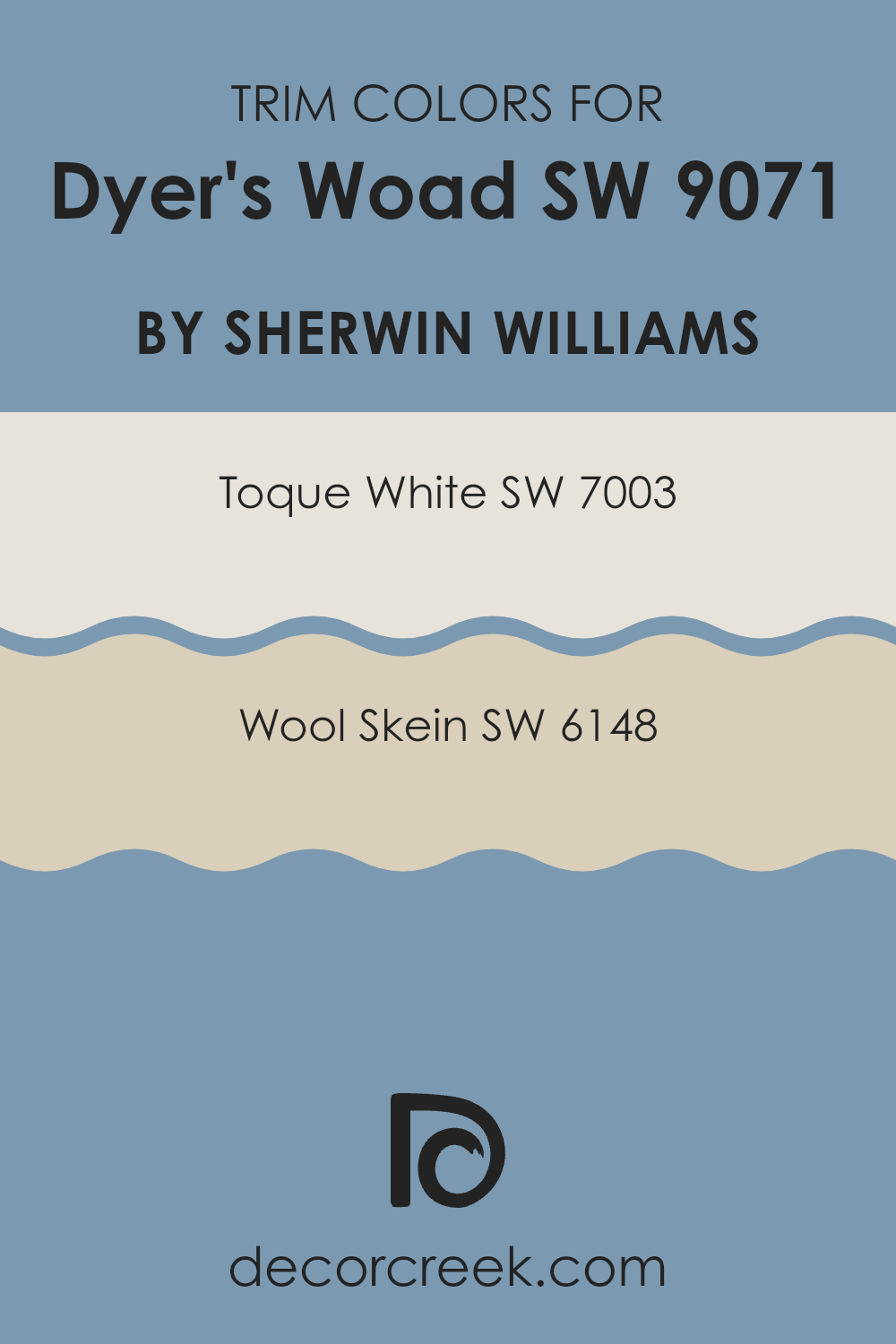
Colors Similar to Dyer’s Woad SW 9071 by Sherwin Williams
Similar colors play a significant role in creating a cohesive and harmonious visual experience in any space. For example, if one were to consider colors similar to Dyer’s Woad by Sherwin Williams, variations like Dried Lavender and Baby Blue Eyes offer a subtle shift in mood while maintaining a fluid visual theme. Dried Lavender provides a muted, gentle purple that meshes smoothly with softer blue hues, whereas Baby Blue Eyes offers a light, airy blue that evokes a sense of calm.
Similarly, Smoky Azurite and Daphne introduce a bit more depth with their richer tones; Smoky Azurite adds a touch of sophisticated mystery with its deep blue, and Daphne offers a vibrant splash, yet remains soothing with its bluish-green tint. This type of color coordination can enhance any living space by connecting different elements smoothly.
The subtle integration continues with additional hues such as Favorite Jeans and Poolhouse, which give off a welcoming and relaxed vibe. Favorite Jeans mimics the comforting and familiar feel of well-worn denim, and Poolhouse echoes the refreshing and invigorating feel of summertime leisure. Other shades like Notable Hue and Bluesy Note also play into this theme by providing deeper, more reflective blues that add a bit of stability and depth to a room.
Bluebird Feather and Lobelia round out the collection with their unique but harmonious tones; Bluebird Feather is lighter and slightly whimsical, perfect for adding a touch of lightness, whereas Lobelia is bold and striking, yet fits within the spectrum of blues that tie everything together. Thus, using similar colors allows for a balanced, pleasing space that feels cohesive and intentionally styled.
You can see recommended paint colors below:
- SW 9072 Dried Lavender
- SW 9070 Baby Blue Eyes
- SW 9148 Smoky Azurite
- SW 9151 Daphne
- SW 9147 Favorite Jeans
- SW 7603 Poolhouse
- SW 6521 Notable Hue
- SW 9064 Bluesy Note
- SW 9062 Bluebird Feather
- SW 6809 Lobelia
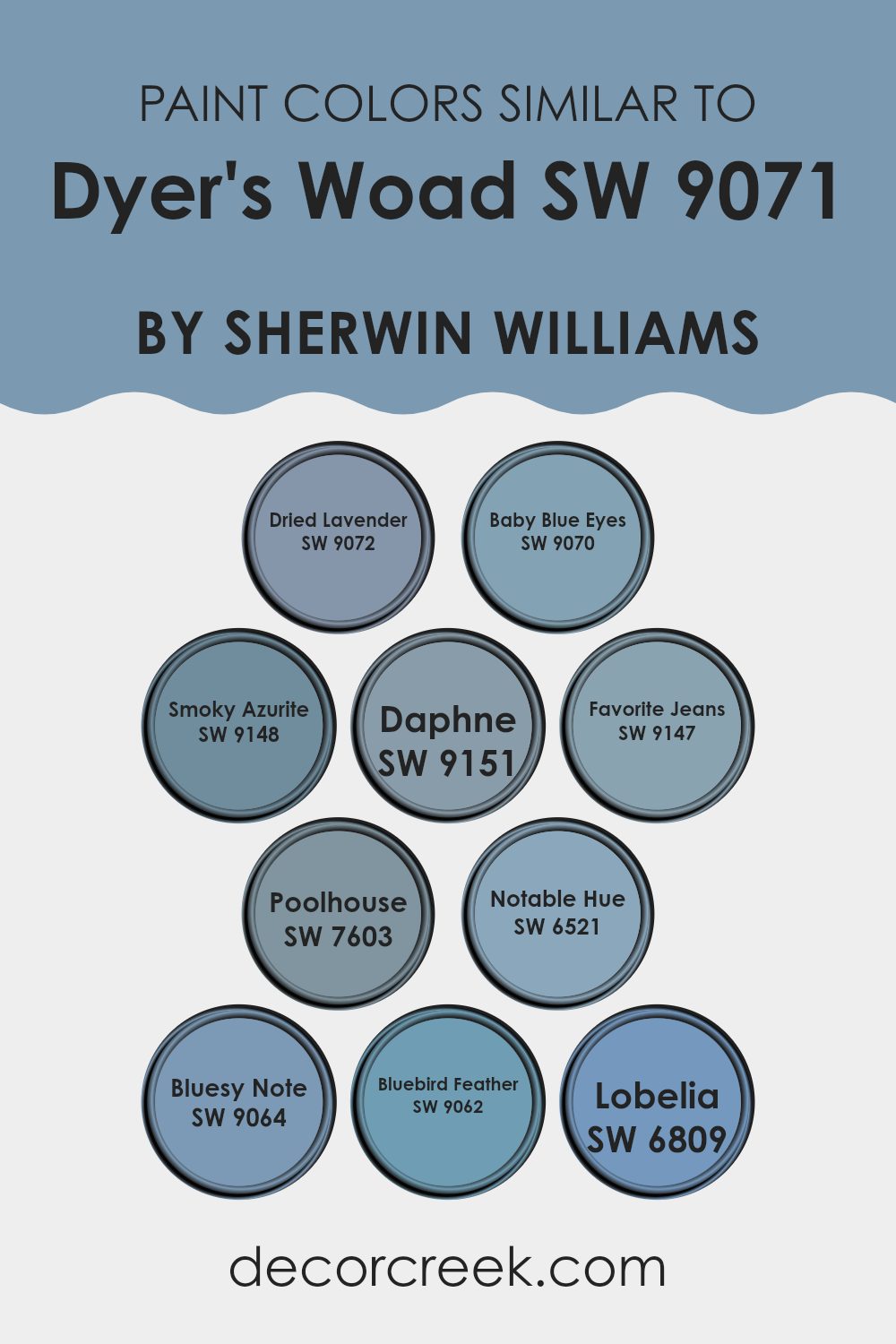
Colors that Go With Dyer’s Woad SW 9071 by Sherwin Williams
Choosing the right colors to pair with Dyer’s Woad SW 9071 by Sherwin Williams is essential for creating a coherent and appealing look in any space. When you pick shades that harmonize well with Dyer’s Woad, you can ensure that the colors flow smoothly from one to another, providing a sense of continuity and balance. For instance, Honest Blue SW 6520 offers a subtle contrast, making it ideal for soft transitions in design. It’s a gentle blue with a calm feel, perfect for adding a bit of color without overwhelming the sense of the space.
Sporty Blue SW 6522, on the other hand, is more vibrant and can bring a dynamic look when combined with Dyer’s Woad. This is great for areas that benefit from a pop of color, such as playrooms or creative spaces. Notable Hue SW 6521 has a deeper, richer tone that pairs elegantly with the light, airy quality of Dyer’s Woad, adding depth and interest to the room.
Commodore SW 6524 offers a stronger, more intense blue, ideal for accent walls or furniture pieces, making the space more lively and inviting. Denim SW 6523 has a relaxed, familiar feel, much like your favorite pair of jeans, that works beautifully to create a comfortable, welcoming atmosphere when used with Dyer’s Woad.
Lastly, Hinting Blue SW 6519 is a much lighter shade that almost acts as a neutral, great for achieving a subtle, refined look that still feels connected to the bolder hue of Dyer’s Woad.
You can see recommended paint colors below:
- SW 6520 Honest Blue
- SW 6522 Sporty Blue
- SW 6521 Notable Hue
- SW 6524 Commodore
- SW 6523 Denim
- SW 6519 Hinting Blue
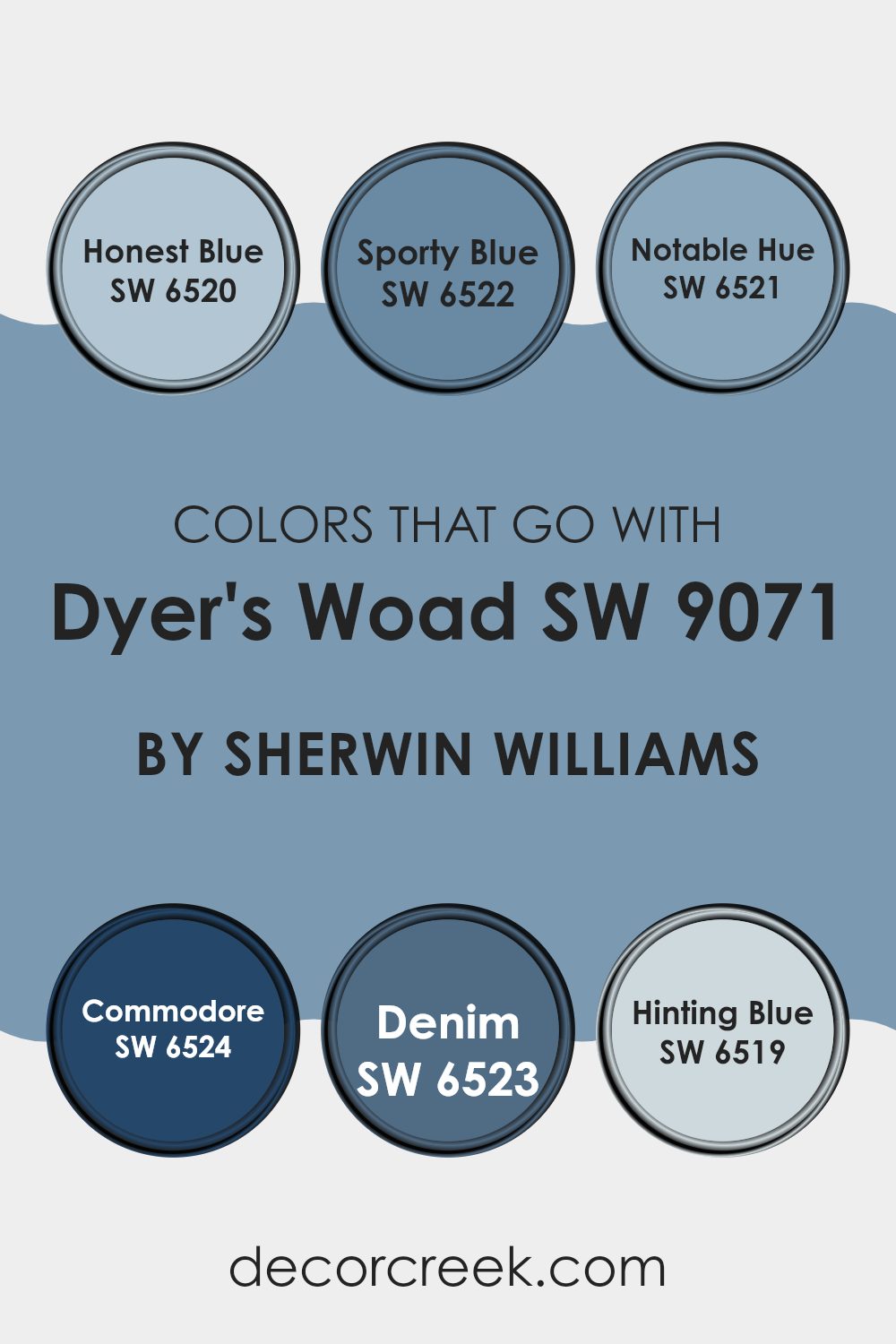
How to Use Dyer’s Woad SW 9071 by Sherwin Williams In Your Home?
Dyer’s Woad SW 9071 by Sherwin Williams is a vibrant yet deep blue paint color that brings a fresh and energetic feel to any room. This shade is perfect for those looking to add a pop of color without overwhelming their space. It works well in various parts of the home, like living rooms or bedrooms, adding a lively touch to walls or even furniture pieces.
You can use Dyer’s Woad to paint an accent wall, creating a focal point in the room that draws the eye and adds interest. It’s also great for small spaces, such as a powder room or an entryway, where it can make the area feel more inviting and lively.
Additionally, pairing it with neutral colors like whites, grays, or even lighter blues can help balance its intensity, providing a pleasant contrast that makes both colors stand out more. This versatility makes Dyer’s Woad a great choice for adding a distinctive touch to your home décor.
Dyer’s Woad SW 9071 by Sherwin Williams vs Bluebird Feather SW 9062 by Sherwin Williams
The main color, Dyer’s Woad, is a soft and gentle gray with subtle blue undertones. It gives off a calm and peaceful vibe, making it a great choice for spaces where you want to relax, like bedrooms or living rooms. Its neutral base means it pairs well with a variety of decor styles and colors, blending seamlessly into various settings.
In contrast, Bluebird Feather is a brighter, more vivid blue. This color has a cheerier and more energetic feel, perfect for adding a pop of color to a space. It’s especially well-suited for areas where you want to create a lively atmosphere, such as kids’ rooms or creative spaces like home offices.
While both colors share a base in the blue family, Dyer’s Woad is more muted and versatile, whereas Bluebird Feather stands out more and offers a fresher, more dynamic look.
You can see recommended paint color below:
- SW 9062 Bluebird Feather
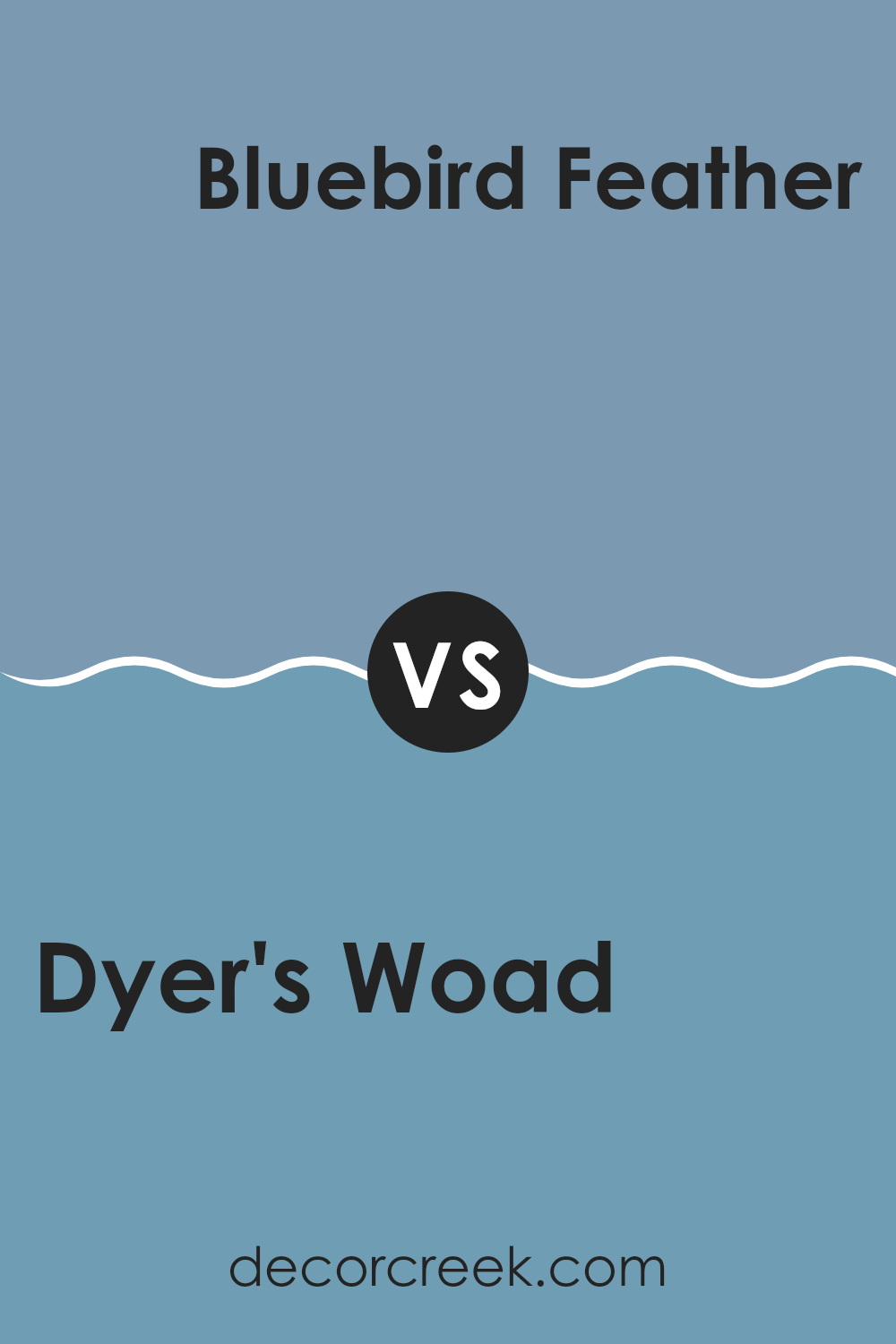
Dyer’s Woad SW 9071 by Sherwin Williams vs Baby Blue Eyes SW 9070 by Sherwin Williams
Dyer’s Woad and Baby Blue Eyes are two distinct colors from Sherwin Williams, each offering a unique vibe. Dyer’s Woad is a deep, soothing navy blue that gives a solid and grounding effect. It’s perfect for creating a strong presence in a space, making it ideal for accent walls or furniture pieces.
On the other hand, Baby Blue Eyes is a lighter, softer shade of blue that feels airy and refreshing. It’s much gentler compared to Dyer’s Woad and works beautifully in spaces that aim for a calm and light atmosphere, like bedrooms or bathrooms.
While both colors share a blue base, the intensity and depth of Dyer’s Woad make it more suited for bold, dramatic themes. In contrast, Baby Blue Eyes offers a tender touch, enhancing spaces with a sense of openness and light. These differences make each color suitable for different purposes and moods in interior design.
You can see recommended paint color below:
- SW 9070 Baby Blue Eyes
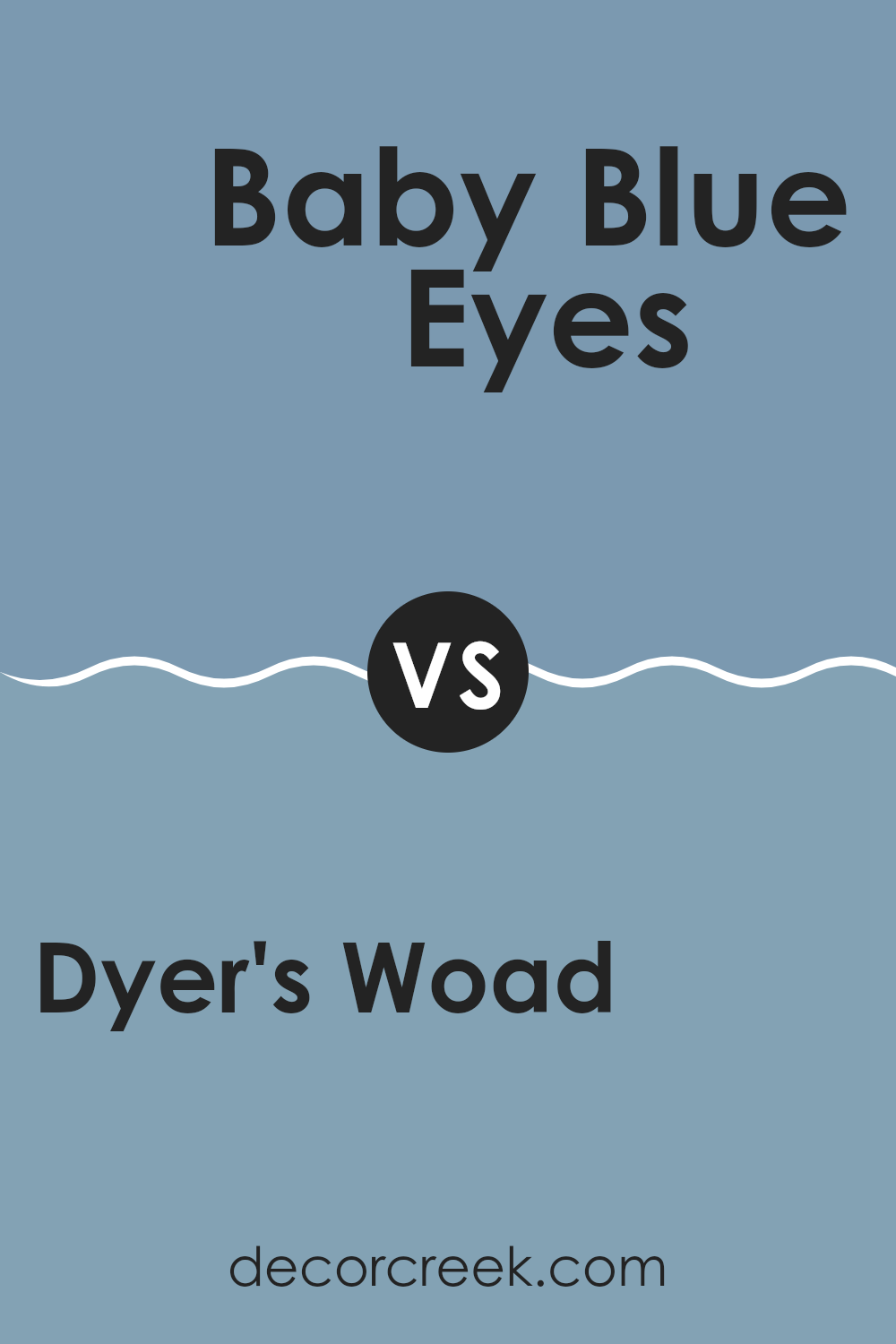
Dyer’s Woad SW 9071 by Sherwin Williams vs Daphne SW 9151 by Sherwin Williams
Dyer’s Woad and Daphne, both from Sherwin Williams, offer distinct hues for varied tastes in décor. Dyer’s Woad is a deep, rich blue with a hint of gray, giving it a muted yet profound presence that works well in spaces meant to have a calming effect, like bedrooms or quiet sitting areas. It pairs beautifully with softer whites or even bolder yellows for a striking contrast.
On the other hand, Daphne is a light, airy shade of blue with green undertones. It offers a refreshing and clean feel, making it perfect for bathrooms, kitchens, or any area where a bright and open atmosphere is desired. It complements well with darker blues and grays, allowing for a balanced and harmonious look.
Both colors have their unique charm and can significantly alter the mood of a room depending on how they are used. Whether looking for the depth and maturity of Dyer’s Woad or the cheerful brightness of Daphne, both colors provide excellent options to enhance your living spaces.
You can see recommended paint color below:
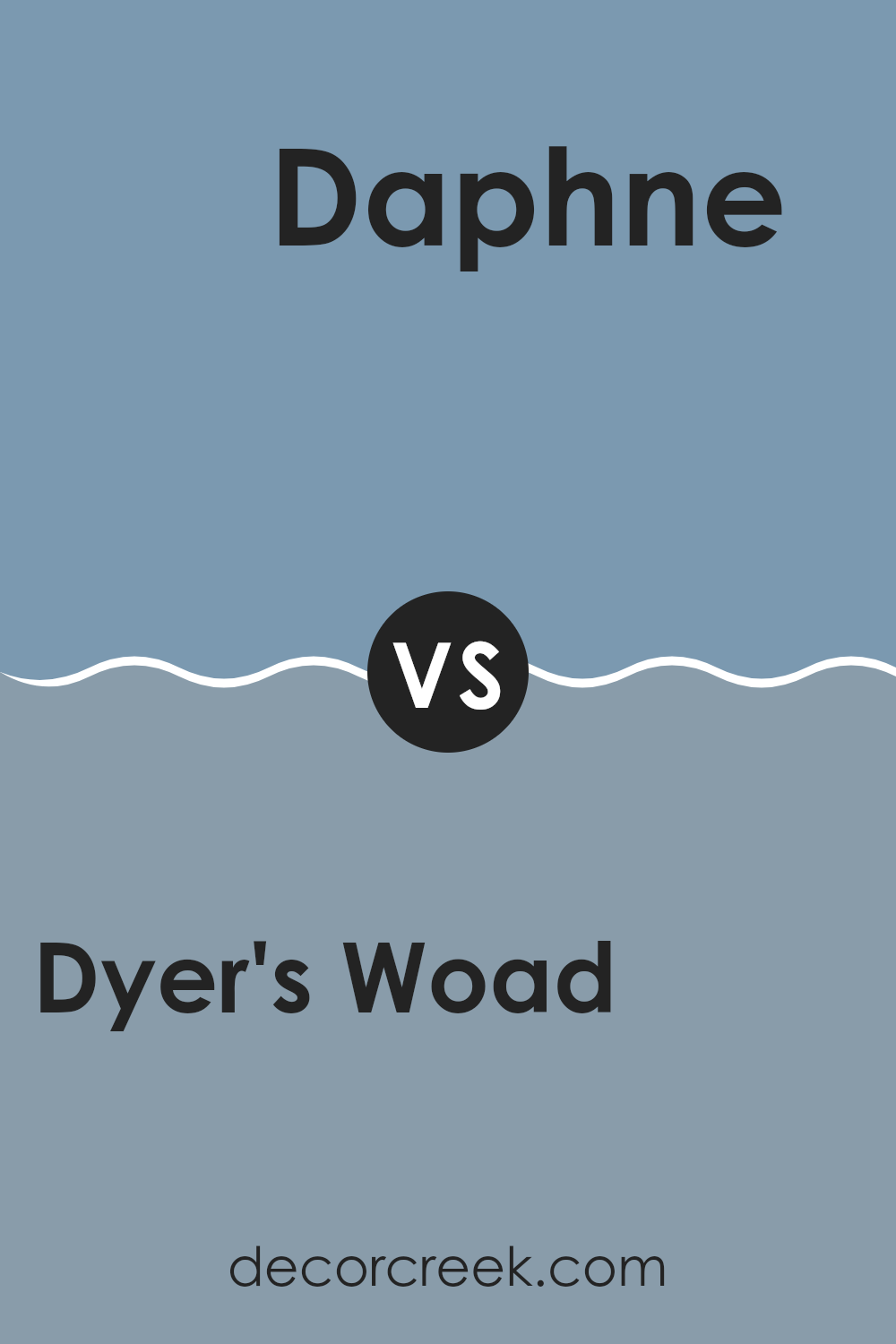
Dyer’s Woad SW 9071 by Sherwin Williams vs Favorite Jeans SW 9147 by Sherwin Williams
“Dyer’s Woad” and “Favorite Jeans” are both blue shades from Sherwin Williams, but they have distinct tones that set them apart. Dyer’s Woad is a lighter blue with a soft, subtle vibe. It’s perfect for creating a calm and gentle atmosphere in spaces like living rooms or bedrooms.
On the other hand, Favorite Jeans has a deeper, more pronounced blue that resembles the classic color of well-worn denim. This makes it ideal for adding a bit of a bolder statement to a room.
While both colors share a blue base, the lighter tone of Dyer’s Woad offers a more understated feel, whereas Favorite Jeans brings a stronger presence that can make wall colors pop more visibly. These differences make each color suitable for different decorating needs and preferences, depending on the mood you want to set in your space.
You can see recommended paint color below:
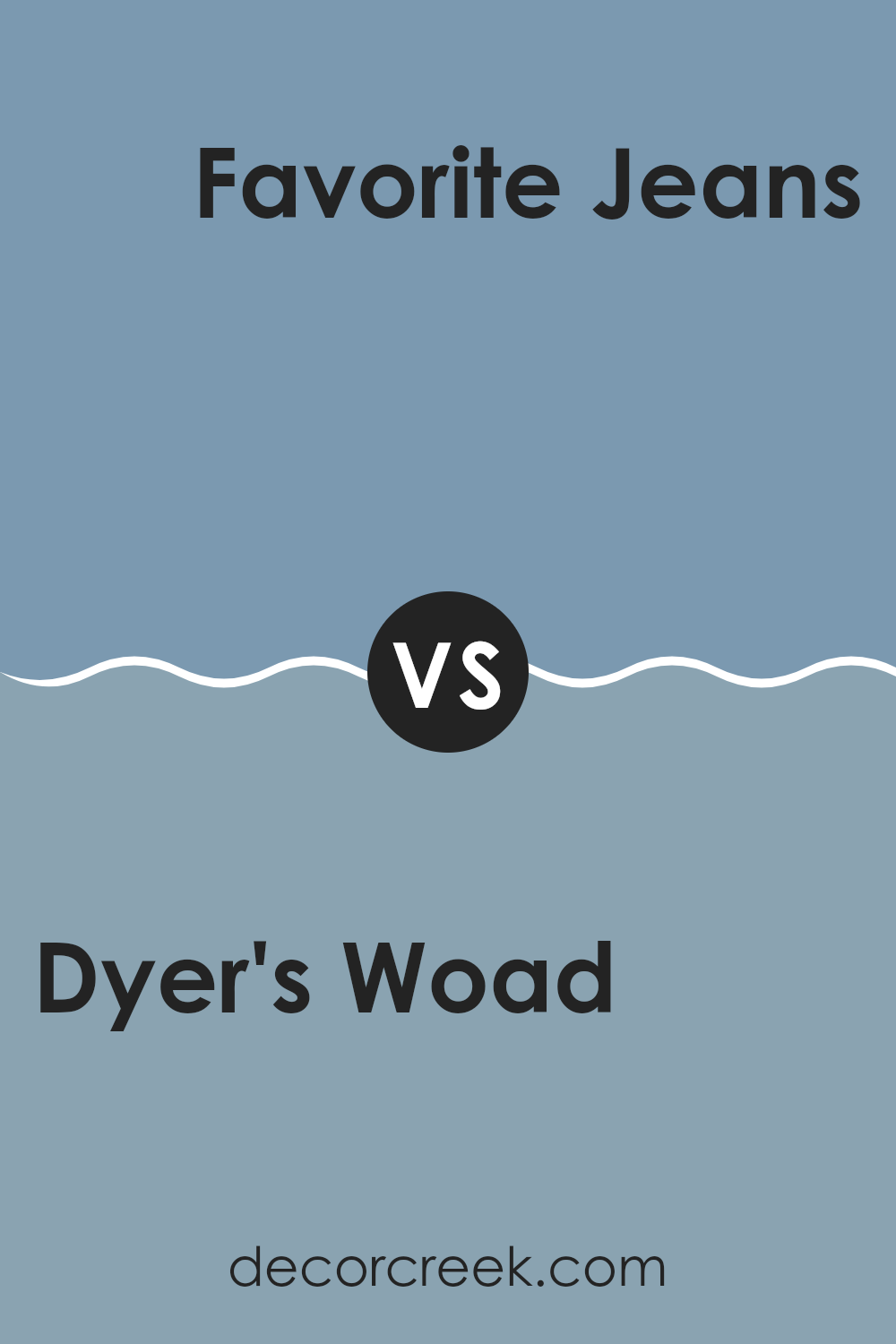
Dyer’s Woad SW 9071 by Sherwin Williams vs Bluesy Note SW 9064 by Sherwin Williams
When comparing Dyer’s Woad and Bluesy Note by Sherwin Williams, both colors fall into the blue family but have distinct tones. Dyer’s Woad has a calm and muted gray-blue shade that gives off a soft, subdued look.
This makes it versatile for use in various spaces, contributing to a peaceful and gentle atmosphere. On the other hand, Bluesy Note stands out with a deeper and more pronounced blue hue that carries a hint of richness. This color is more likely to draw attention and can make a strong statement in a room.
Bluesy Note works well as an accent color or in areas where you want to add a bit of drama. Overall, while both colors offer the coolness and calm associated with blue tones, Dyer’s Woad provides subtlety and softness, whereas Bluesy Note offers depth and boldness.
You can see recommended paint color below:
- SW 9064 Bluesy Note
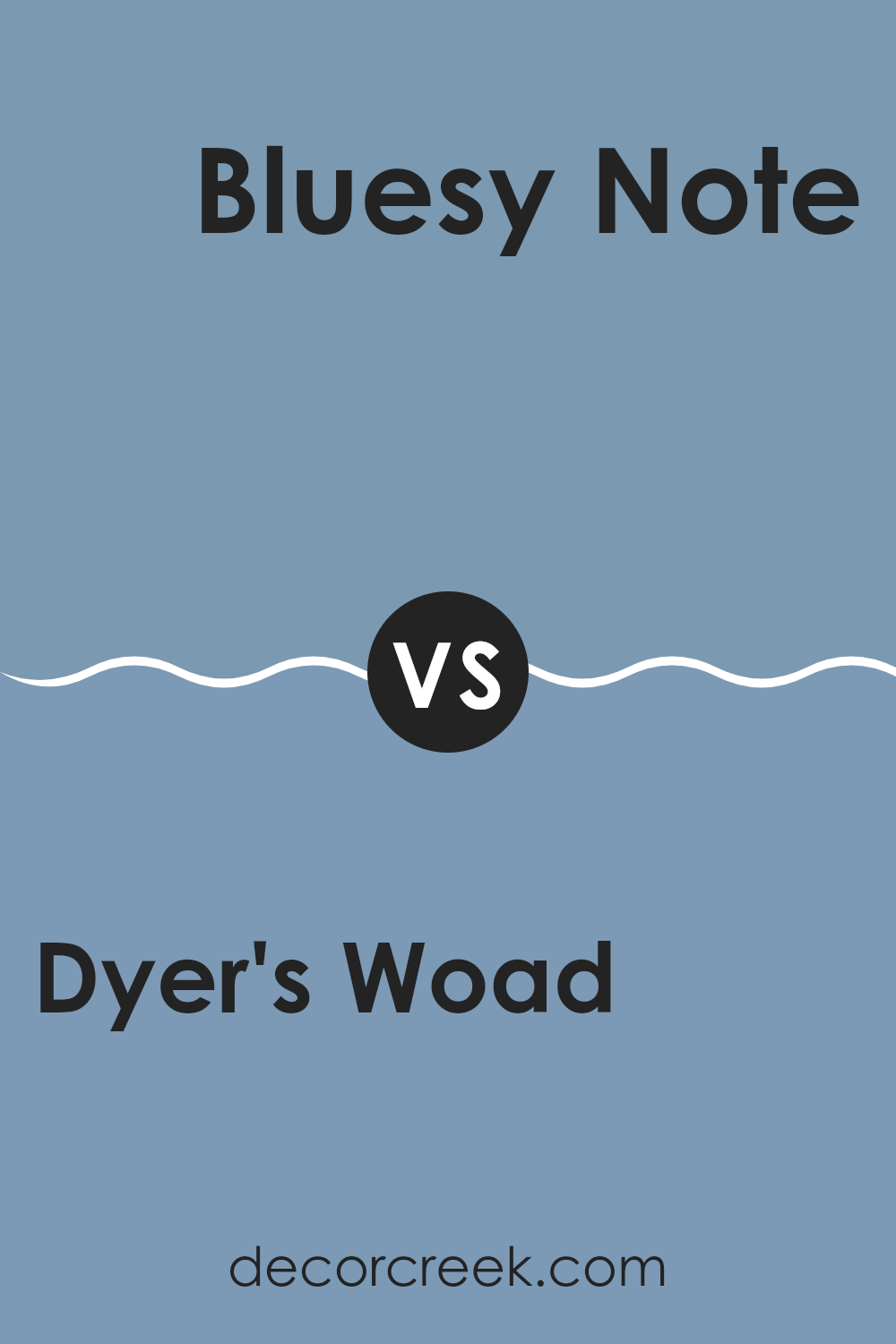
Dyer’s Woad SW 9071 by Sherwin Williams vs Dried Lavender SW 9072 by Sherwin Williams
Dyer’s Woad and Dried Lavender, both by Sherwin Williams, are subtle yet distinct hues perfect for different aesthetic moods. Dyer’s Woad is a soft grey with a hint of blue, giving a calm and soothing vibe to any space. It’s light enough to make small rooms appear larger while still adding a touch of color.
On the other hand, Dried Lavender has a gentle purple tone, leaning slightly towards a muted lilac. This color is great for creating a cozy, inviting atmosphere in areas like bedrooms or living rooms. It’s warmer compared to Dyer’s Woad and works wonderfully in spaces that seek a hint of warmth without overwhelming the senses.
Both colors are versatile and work well in homes aiming for a modern yet understated feel. They pair beautifully with whites and creams for a clean, minimal look, or can be matched with bolder colors to make a statement.
You can see recommended paint color below:
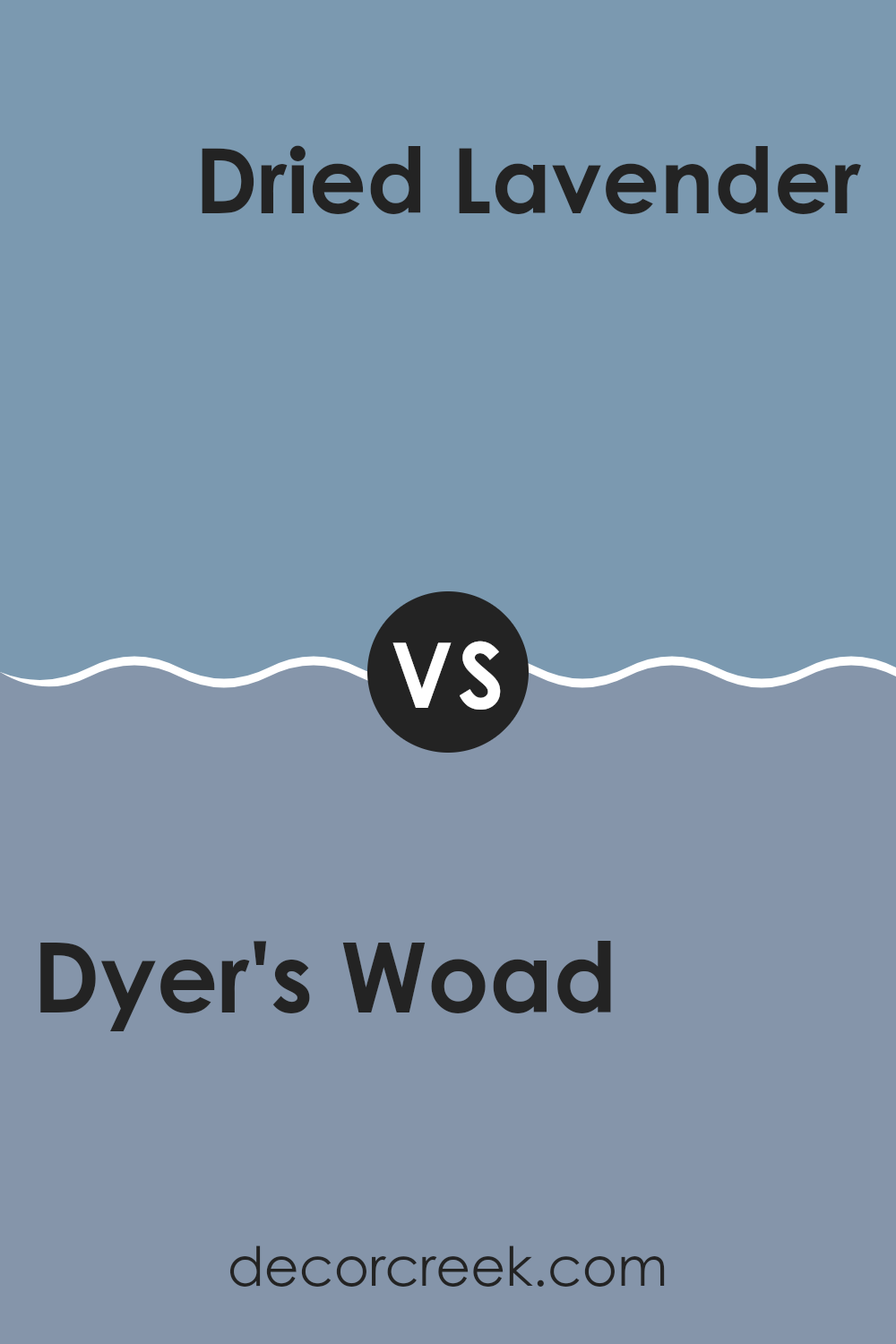
Dyer’s Woad SW 9071 by Sherwin Williams vs Lobelia SW 6809 by Sherwin Williams
Dyer’s Woad and Lobelia, both by Sherwin Williams, present unique shades contributing distinct vibes to any space. Dyer’s Woad is a muted blue with gray undertones, giving it a subtle and calm appearance. It’s a great choice if you want a color that’s soft and not too loud, making it perfect for a peaceful bedroom or a quiet study area.
On the other hand, Lobelia is a much brighter and more vibrant blue. It has a punchy, lively feel that can instantly brighten up a room. This color would be ideal for areas like playrooms or creative spaces where you want to add some energy and fun.
The choice between these two depends on what mood you’re aiming for in your space. If you prefer something gentler and more understated, go for Dyer’s Woad. If you’re after a pop of color and excitement, Lobelia is the way to go. Both colors offer beautiful blue hues but cater to different tastes and settings.
You can see recommended paint color below:
- SW 6809 Lobelia
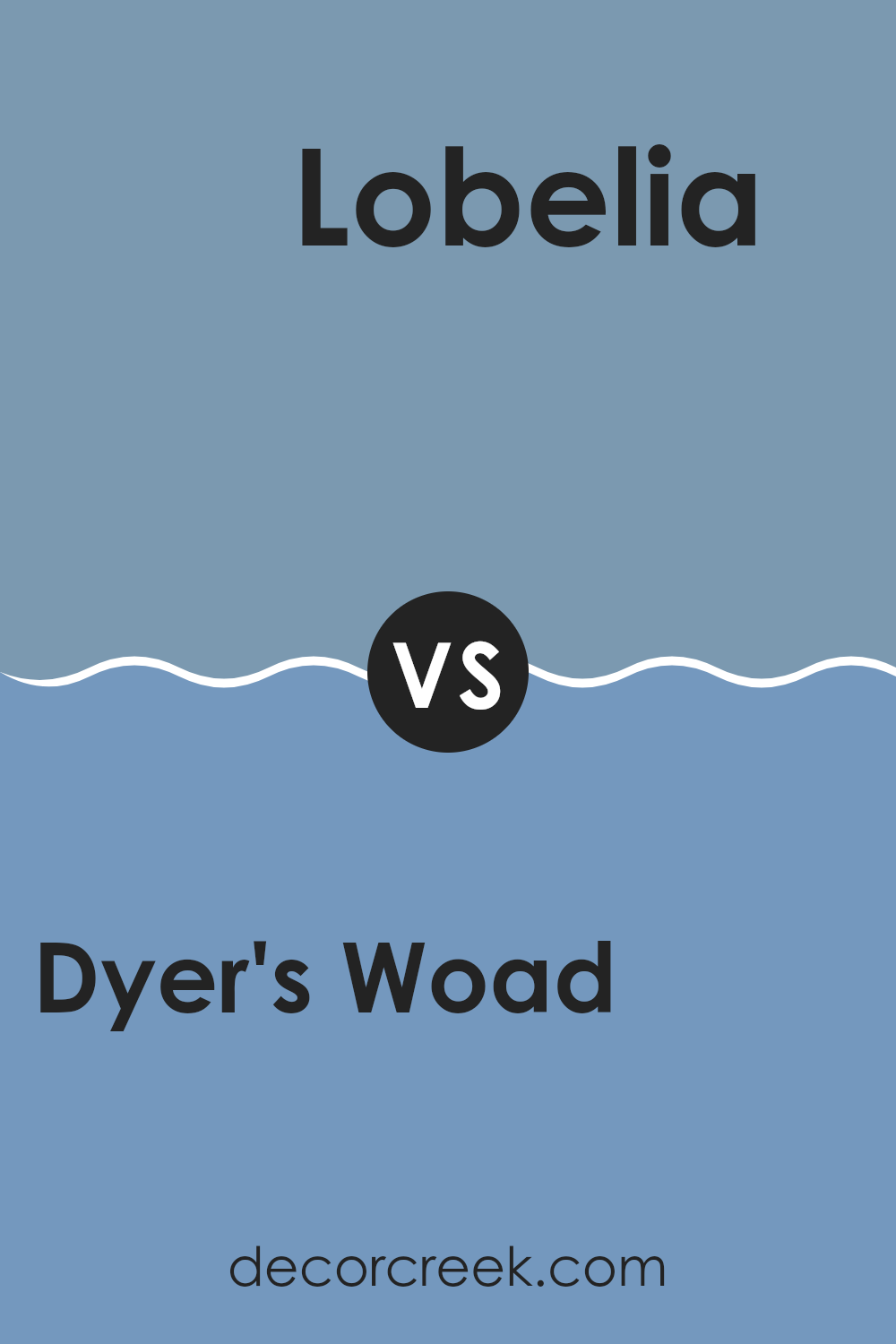
Dyer’s Woad SW 9071 by Sherwin Williams vs Notable Hue SW 6521 by Sherwin Williams
Dyer’s Woad is a muted gray-blue that has a subtle, soft presence which makes it very adaptable for various spaces. It’s gentle enough to be used in large areas like living rooms or bedrooms without overwhelming the space. It partners well with both bright and neutral shades, giving decorators a lot of flexibility.
On the other hand, Notable Hue stands out with its deeper and more vibrant blue tone. This color can make a bold statement when used as an accent wall or in decorative touches throughout a room. While Dyer’s Woad provides a backdrop, Notable Hue draws attention and can add a pop of color that brings life to neutral color schemes.
Both colors offer unique appeals – Dyer’s Woad for its understated elegance and ease of pairing, and Notable Hue for its ability to inject vibrancy and focus into a space. Whether you’re aiming for a calm retreat or a dynamic area, these colors can suit different tastes and design needs.
You can see recommended paint color below:
- SW 6521 Notable Hue
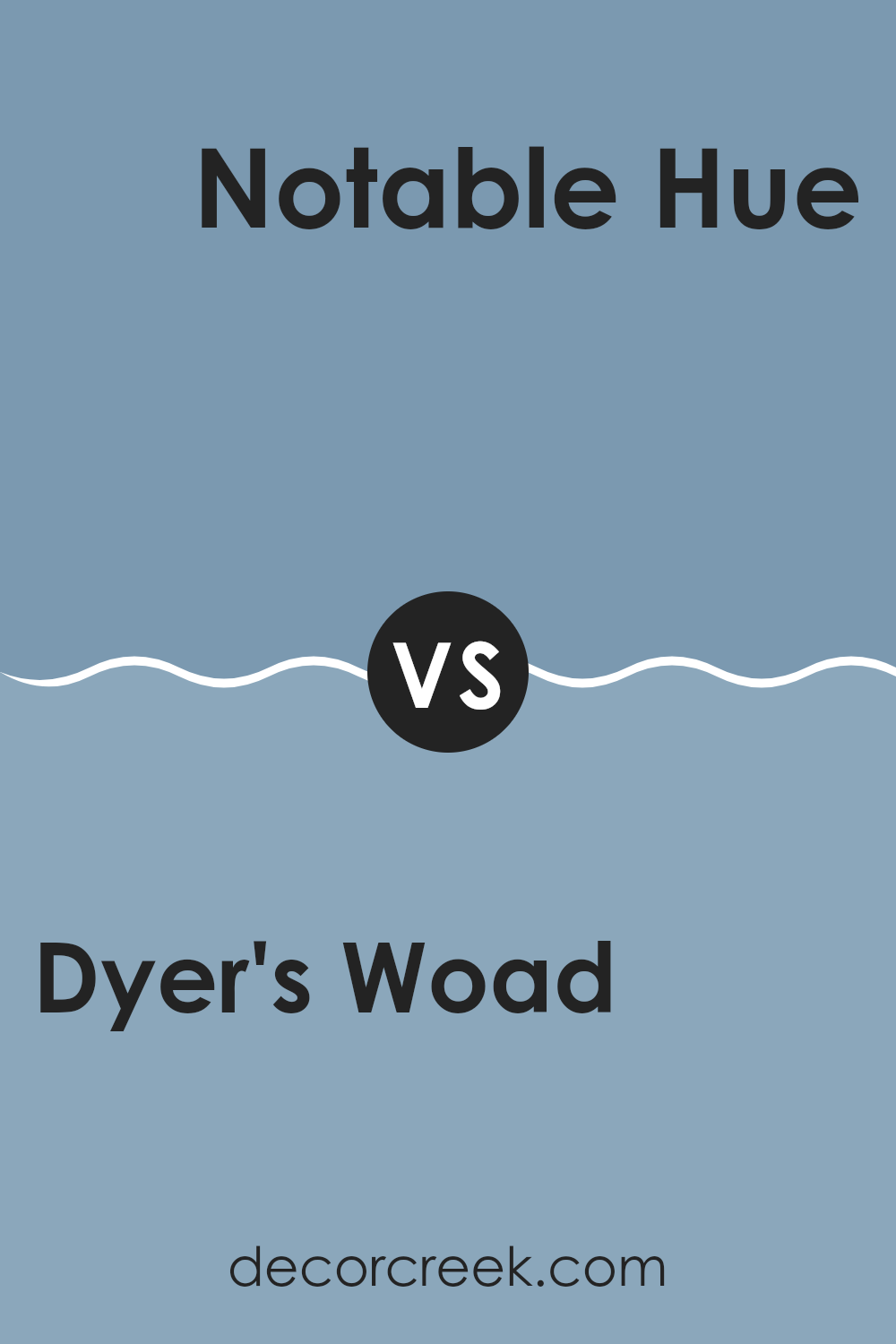
Dyer’s Woad SW 9071 by Sherwin Williams vs Smoky Azurite SW 9148 by Sherwin Williams
Dyer’s Woad and Smoky Azurite are both inspired by shades of blue, but they offer distinct vibes to any space. Dyer’s Woad is a softer, lighter blue that brings a fresh and airy feel to rooms, making it ideal for spaces where you want to create a relaxed atmosphere, such as bedrooms or bathrooms. This color has a calmness to it, reminding one of a clear sky on a sunny day.
On the other hand, Smoky Azurite is a deeper, more intense blue with a hint of gray. This color delivers a stronger presence, suitable for creating a more dramatic effect in areas like living rooms or dining areas. It’s like looking into a deep ocean, providing a bold backdrop that can highlight décor and furniture.
Both these colors, while rooted in blue, serve different purposes based on their depth and tone. Dyer’s Woad works well in softer, lighter spaces, and Smoky Azurite stands out in settings where a touch of drama is desired.
You can see recommended paint color below:
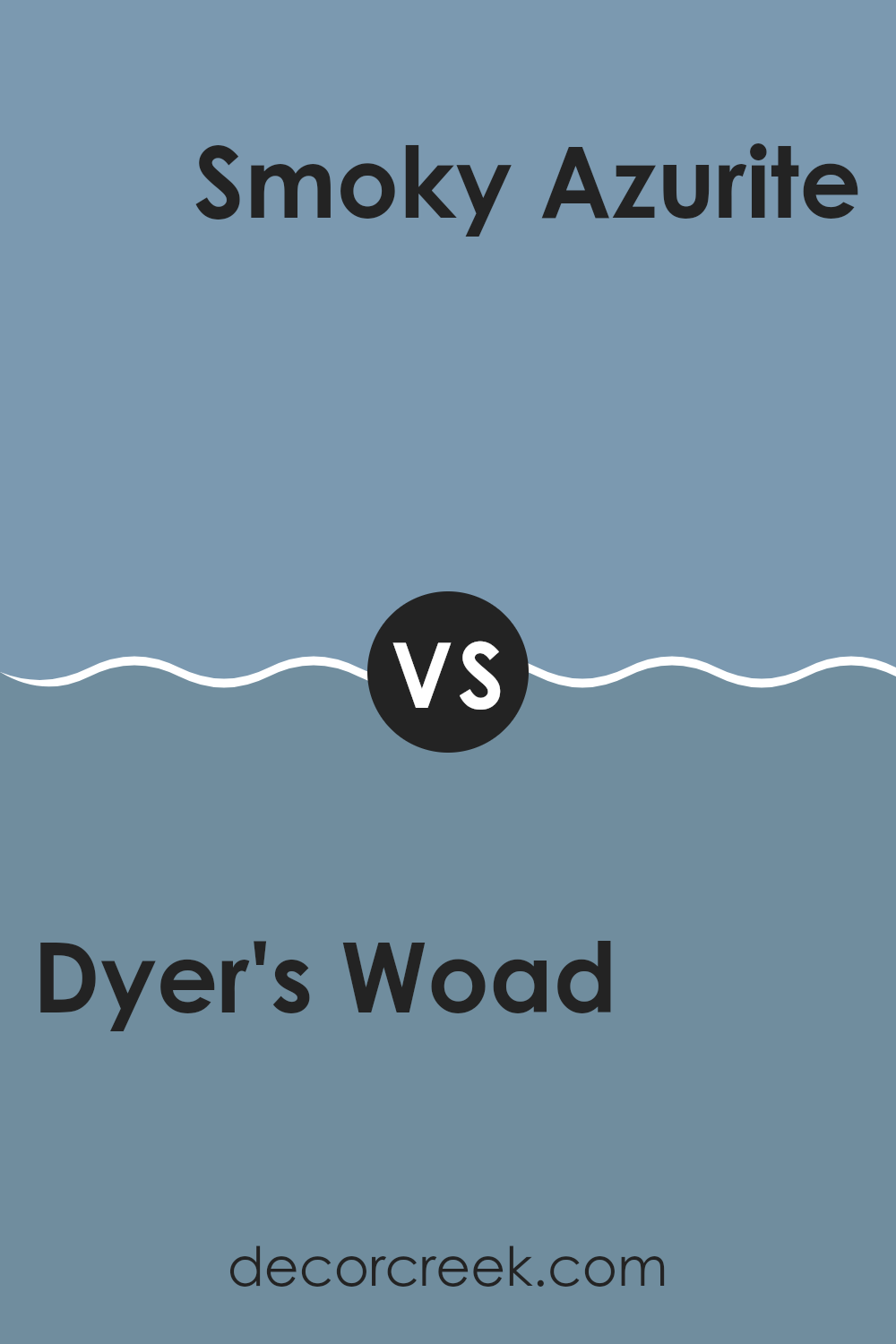
Dyer’s Woad SW 9071 by Sherwin Williams vs Poolhouse SW 7603 by Sherwin Williams
Dyer’s Woad and Poolhouse are two distinct paint colors by Sherwin Williams. Dyer’s Woad is a deep, muted blue with a hint of gray, giving it a calm and grounded feel. It’s a color that pairs well with whites and grays, offering a subtle yet strong presence in a room.
On the other hand, Poolhouse is a vibrant, light aqua blue that has a refreshing and lively vibe. This color works great in spaces that could use a bright touch, especially bathrooms and kitchens, where it adds a fresh and clean look.
When comparing these two, Dyer’s Woad is more understated and versatile, suitable for both modern and traditional spaces, while Poolhouse stands out more and brings a cheerful energy to any area. Both colors provide their unique atmosphere, so choosing between them depends on the desired mood for the space.
You can see recommended paint color below:
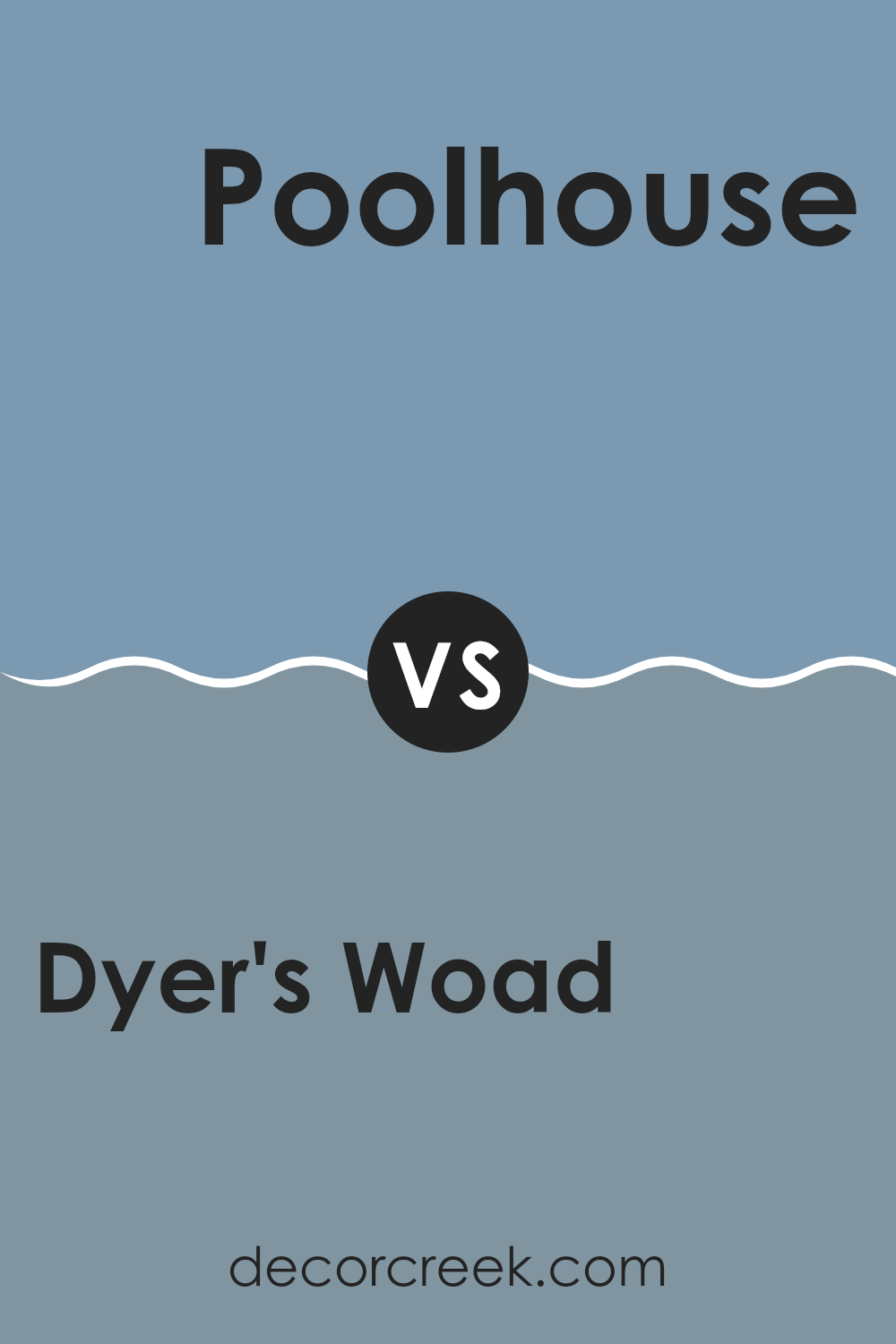
Conclusion
As someone who loves seeing how colors can change the look of a room, I was really excited to learn about SW 9071 Dyer’s Woad by Sherwin Williams. This color is a special kind of blue that has a peaceful, not-too-bright and not-too-dark quality to it. After reading all about it, I think it’s a fantastic choice for anyone wanting to make their room feel calm and cozy.
What’s great about Dyer’s Woad is that it isn’t just a normal blue; it has a slight hint of gray which makes it perfect for matching with lots of different colors and styles in your room. You can use it in your bedroom to help you feel relaxed, or in your living room to create a welcoming atmosphere for your friends and family.
After trying out this color and seeing it in different lights throughout the day, I am even more impressed. Whether it’s morning or evening, the color holds its unique charm and doesn’t turn too dark or too bright, which is really cool.
In the end, if you’re thinking about painting a room and want a color that is easy on the eyes and flexible enough to fit with different themes, Dyer’s Woad by Sherwin Williams is a wonderful pick. It’s fascinating how much a single can of paint can change a room and make it feel brand new!
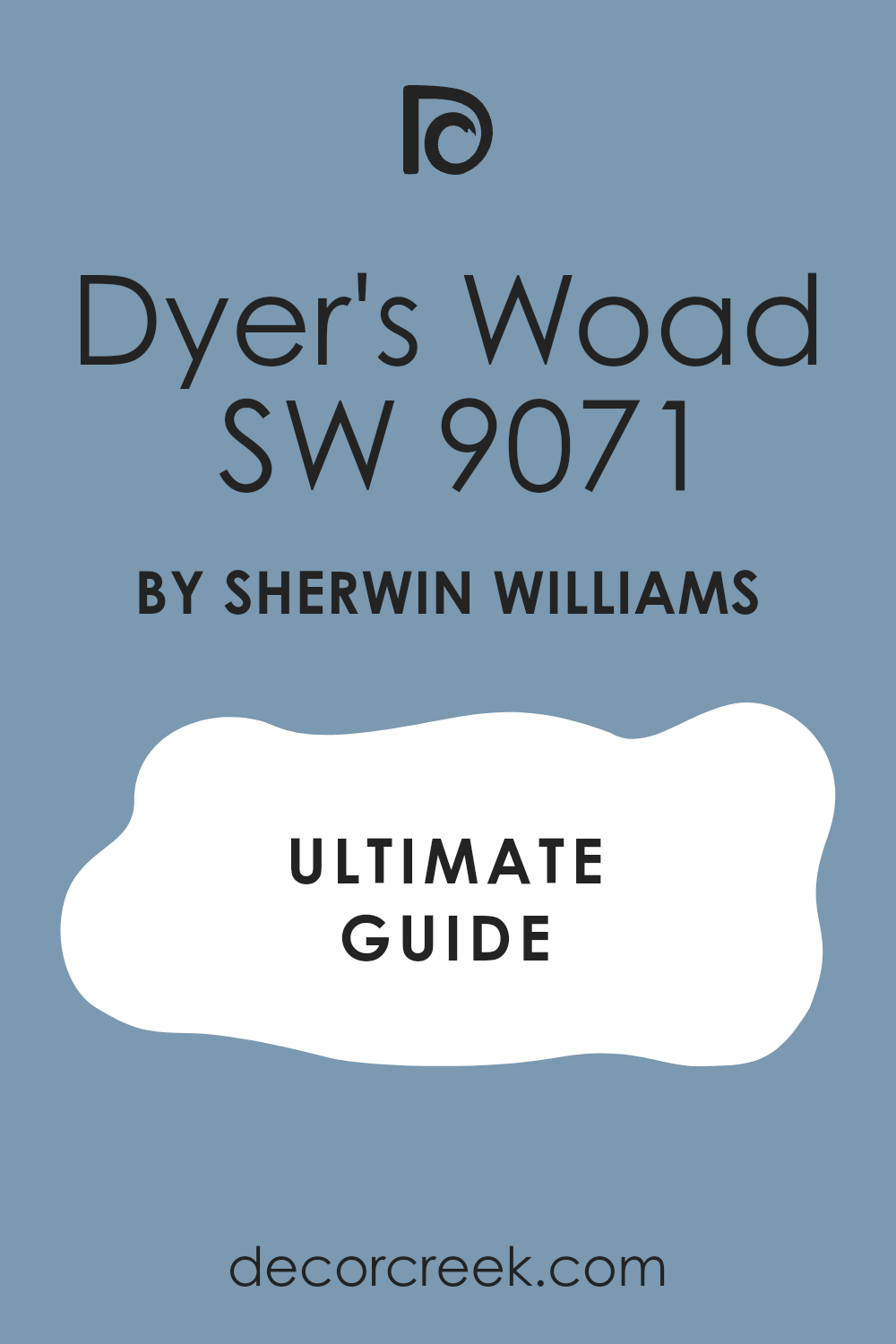
Ever wished paint sampling was as easy as sticking a sticker? Guess what? Now it is! Discover Samplize's unique Peel & Stick samples.
Get paint samples



